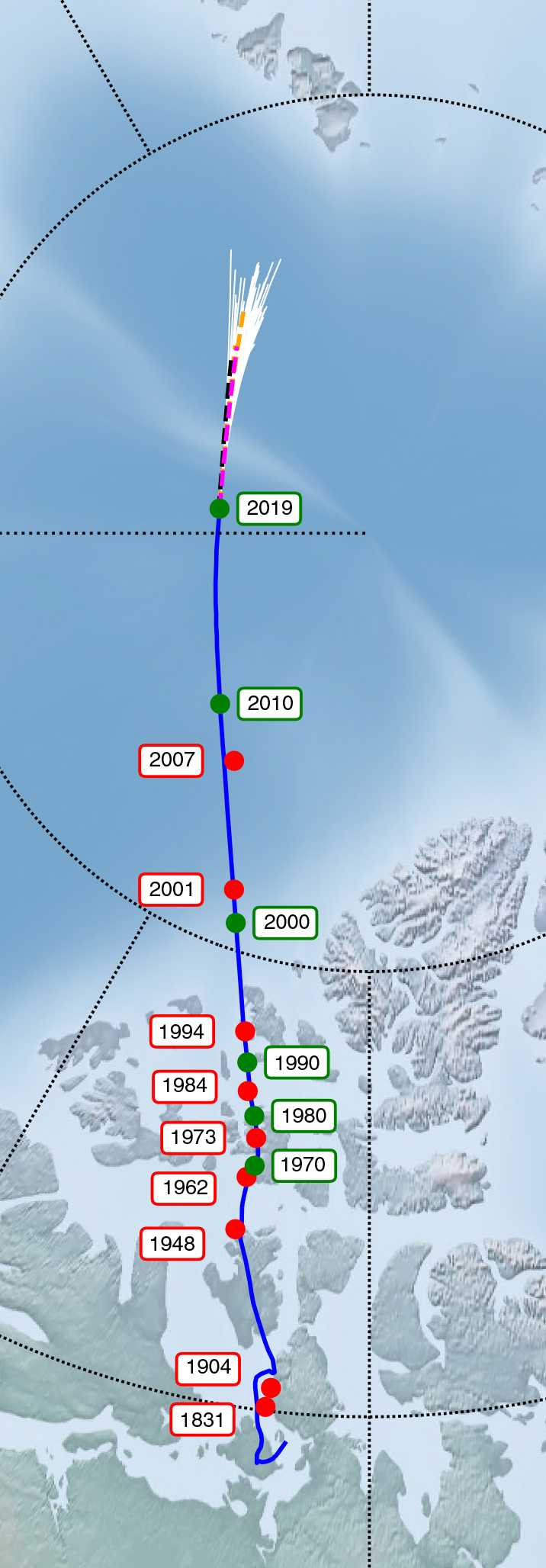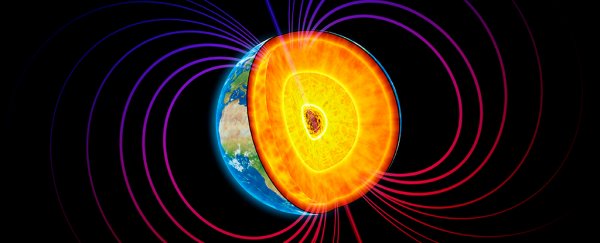Our planet wears its magnetic field like an oversized coat that just won't sit comfortably. All that sliding means the north magnetic pole is destined to move ever closer to Siberia's coastline over the coming decade.
There's no conspiracy behind it - but the geological forces responsible have been something of a mystery. Now, we might be a little closer to understanding what's going on.
Researchers from the University of Leeds in the UK and the Technical University of Denmark have analysed 20 years of satellite data, finding that a monolithic competition between two lobes of differing magnetic force near the core is likely to be behind the pole's wanderlust.
When the precise position of Earth's magnetic north was located for the first time back in 1831, it was squarely in Canada's corner of the Arctic, on the Boothia Peninsula in the territory of Nunavut.
Ever since, fresh sets of measurements have recorded this spot drift north by an average of around 15 kilometres (about 9 miles) every year.
Advanced technology means we can now keep a careful watch on the pole's location with unprecedented accuracy. Prior to the 1970s, the north magnetic pole's position was like a drunken stagger. Since then, it's had a mission, marching in a straight line, building speed.
Since the 1990s, its movement has quadrupled in speed, to a current rate of between 50 and 60 kilometres (about 30 and 37 miles) a year. In late 2017, the pole's sprint brought it within 390 kilometres (240 miles) of the geographical north pole.
 Tracking the magnetic north pole's drift towards Siberia (Livermore etal., Nature Geoscience, 2020)
Tracking the magnetic north pole's drift towards Siberia (Livermore etal., Nature Geoscience, 2020)
On its current trajectory, we can expect it to be anywhere between 390 and 660 kilometres (240 and 410 miles) further along its journey in ten years, bringing it within a whisker of the northern limits of the East Siberian Sea.
The rapid displacement is a concern for navigation systems that rely on pinpoint calculations of the pole's location, forcing the US National Geophysical Data Center to fast track its usual updates to the World Magnetic Model last year.
What the world really needs is a solid idea of the physical mechanisms behind this displacement, allowing for accurate predictions on the planet's magnetic movements.
So Earth scientists Philip Livermore and Matthew Bayliff from the University of Leeds in the UK and Christopher Finlay from the Technical University of Denmark reviewed 20 years of geomagnetic data from the ESA's Swarm mission.
The pole's heading lines up neatly with two anomalies called negative magnetic fluxes, one deep beneath Canada, and the other below Siberia.
"The importance of these two patches in determining the structure of the field close to the north magnetic pole has been well known for several centuries," the researchers note in their recently published report.
These large lobes of magnetism grow and shrink with time, having a profound effect on the magnetic field we perceive on the surface.
Between 1970 and 1999, changes to interactions between the flowing mantle and the planet's dense, spinning core caused the patch beneath Canada to elongate, reducing the corresponding magnetic field's strength to drop up top.
"Now historically, the Canadian patch has been winning the war and that's why the pole has been centred over Canada," Livermore told BBC Radio 4's Today programme in a recent interview.
"But in the last few decades, the Canadian patch has weakened and the Siberian patch has strengthened slightly, and that explains why the pole has suddenly accelerated away from its historical position."
While this means we can expect the pole to continue racing for a little longer, it doesn't tell us precisely where it will stop, how long it will stop for, or when it might return.
There is an incredible amount we don't know about the engine whirring away inside our planet's guts.
Given that extensive geological records hint at significant fluctuations in its protective magnetic field, we really ought to know a lot more than we do.
We're going to need more models like this if we're to have a hope of predicting just where our planet's poles will end up in the future.
This research was published in Nature Geoscience.
